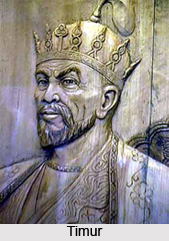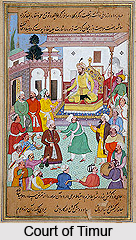 The invasion of Timur in India took place in the year 1398 A.D. Timur`s objective of attacking India was to fight against and destroy the rulers of India in order to plunder their wealth. Timur started his journey towards India from Samarqand in April 1398 A.D. He crossed the Sindh River in September and entered Punjab. The invasion of Timur led to the destruction of the power of the Delhi Sultanate and the Tughlaq dynasty. Prior to his invasion, his grandson Pir Muhammad, the governor of Kabul, had already sent an expeditionary force against India which had captured Uch and besieged Multan. Pir Muhammad joined Timur after the capture of Multan. The governor of the fort of Bhatnir submitted after a brief resistance and the fort and the city were destroyed by Timur. Thereafter Timur proceeded towards Delhi massacring people and destroying everything which came in his way.
The invasion of Timur in India took place in the year 1398 A.D. Timur`s objective of attacking India was to fight against and destroy the rulers of India in order to plunder their wealth. Timur started his journey towards India from Samarqand in April 1398 A.D. He crossed the Sindh River in September and entered Punjab. The invasion of Timur led to the destruction of the power of the Delhi Sultanate and the Tughlaq dynasty. Prior to his invasion, his grandson Pir Muhammad, the governor of Kabul, had already sent an expeditionary force against India which had captured Uch and besieged Multan. Pir Muhammad joined Timur after the capture of Multan. The governor of the fort of Bhatnir submitted after a brief resistance and the fort and the city were destroyed by Timur. Thereafter Timur proceeded towards Delhi massacring people and destroying everything which came in his way.
 Till then Sultan Nasir- ud- din of the Tughlaq dynasty had done nothing to resist the invader. When finally the Sultan and his wazir Mallu Iqbal attacked the army of Timur, they were easily defeated. Another battle took place between the Indian army and Timur in 1398 and the Indian army was completely routed. The Sultan and his wazir fled away from the capital. In Delhi, Timur first agreed to spare the citizens when requested by the Ulema, but when the citizens resisted the tyrannical behavior of the soldiers of Timur, he ordered a general massacre and plunder. It continued for several days in which many people were killed, thousands were taken as slave and the entire wealth of the city was plundered.
Till then Sultan Nasir- ud- din of the Tughlaq dynasty had done nothing to resist the invader. When finally the Sultan and his wazir Mallu Iqbal attacked the army of Timur, they were easily defeated. Another battle took place between the Indian army and Timur in 1398 and the Indian army was completely routed. The Sultan and his wazir fled away from the capital. In Delhi, Timur first agreed to spare the citizens when requested by the Ulema, but when the citizens resisted the tyrannical behavior of the soldiers of Timur, he ordered a general massacre and plunder. It continued for several days in which many people were killed, thousands were taken as slave and the entire wealth of the city was plundered.
Timur stayed in Delhi for fifteen days and looted immense wealth. On his way back he plundered Firozabad, Meerut, Haridwar, Kangra and Jammu. He brought unparalled devastation in India. Wherever he went, he completely destroyed every thing. Thousands of villages were burnt, lakhs of people were massacred and all the cities were thoroughly plundered. Timur destroyed the Delhi Sultanate and also the dynasty of the Tughlaqs. Before Timur left India, he appointed Khizr Khan as governor of Multan, Lahore and Dipalpur.



















